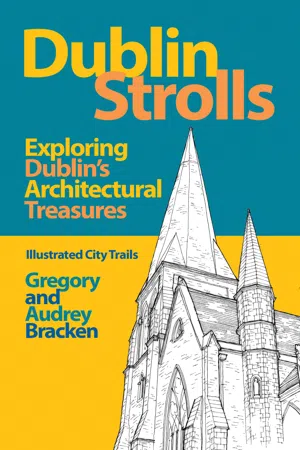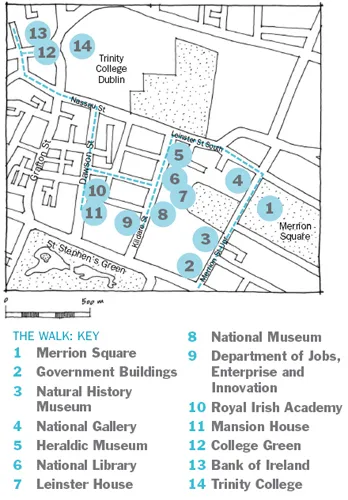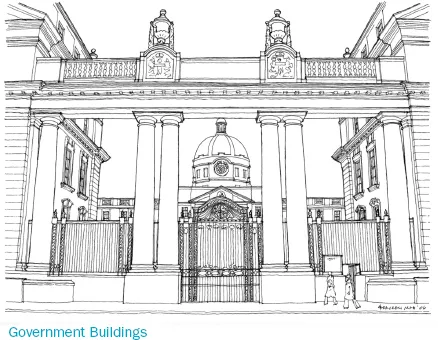![]()
KILDARE STREET TO COLLEGE GREEN
Approximate walking time: 2 hours
THIS DISTRICT IS THE HEART OF DUBLIN’S CULTURAL LIFE, with the National Gallery, National Library and National Museum, as well as the Natural History and Heraldic Museums and the prestigious Royal Irish Academy, all located a stone’s throw from one another. It is also the government district, with Dáil Éireann, Ireland’s parliament, sitting in Leinster House, and a number of fine government offices, including the magnificent complex of Government Buildings itself and the sleek Art Deco Department of Jobs, Enterprise and Innovation. Dawson Street is where the Lord Mayor resides, at the Mansion House, with St Ann’s, one of the area’s decorative churches, just down the road beside the prestigious Royal Irish Academy. The former Church of St Andrew’s is now the Dublin Tourism Office while College Green boasts two of the city’s most important buildings: the Bank of Ireland, originally the world’s first parliament house, and Trinity College, a vast university complex containing leafy quadrangles and Neoclassical buildings. It is also where one of the country’s national treasures is kept: the Book of Kells. Finally, there are some lovely Georgian houses; particularly fine are the terraces facing onto Merrion Square, where this walk begins.
1 Merrion Square
Dublin’s most prestigious address in the nineteenth century, Merrion Square was laid out from the 1760s and became one of the city’s largest and grandest Georgian squares. By the early nineteenth century it had been completed, and the oldest and best houses are located on the north side. Covering approximately 5 hectares (just over 12 acres), the square was not built around an existing park, like St Stephen’s Green or Parnell Square, but by the 1790s planting was complete and railings added. Proximity to Leinster House, which faces onto the square from Leinster Lawn, ensured that it was a fashionable place to live. The garden front of Leinster House nestles between the Natural History Museum and the National Gallery. The rest of Merrion Square consists of uniform-looking terraces, which is surprising because the houses were all built at different times and have differences in doors, windows and parapet heights. Very plain-looking, the only decoration is the colourfully painted front doors and the wrought-iron balconies added in the nineteenth century. Unlike the northside Gardiner Estate, Merrion Square continued to be a popular place to live after the Act of Union. Many of the houses were altered in the nineteenth and early twentieth centuries but most of them were turned into offices in the second half of the twentieth century. Many of them sport blue plaques commemorating famous past residents, including Daniel O’Connell (see p. 159) at number 58 and W. B. Yeats at number 82. Oscar Wilde was brought up at number 1, a corner house with elaborate Victorian additions, and there is a statue of him across the street. Dating from 1997, sculptor Danny Osborne’s garish multicoloured figure has a porcelain face and hands and shows the author lounging on some uncomfortable-looking rocks (perhaps a metaphor for poor Oscar’s career?). Around the corner, facing the National Gallery, is the Rutland Fountain. By Francis Sandys from 1792, this is a memorial to Charles Manners, Duke of Rutland and Lord Lieutenant of Ireland, who died, aged thirty-three, in 1787. A lovely Neoclassical fountain, it has not fared too well despite having been restored in 1975. It is missing a lot of its decoration (the figures in the stone tablet showing the Marquess of Granby relieving a distressed soldier’s family are all headless) and the fountain no longer works. Merrion Square hosts cultural events throughout the year and is also a popular open-air amateur art gallery on Sundays.
MERRION SQUARE
Opening times: daily, 24 hours
Admission: free
MERRION SQUARE OPEN-AIR ART GALLERY
Opening times: Sunday, 10 a.m. – 6 p.m.
Admission: free
2 Government Buildings
Continue along Merrion Square West from the Rutland Fountain, follow Merrion Street Upper and you will come to the Merrion Hotel on your left. Now one of the country’s most luxurious hotels, with beautifully decorated period rooms full of Irish artwork, it also boasts some of the city’s best restaurants and a lovely interior garden. Originally called Mornington House, it is where Arthur Wellesley, first Duke of Wellington and third son of the first Earl of Mornington, is supposed to have been born in 1769. The family moved here from Grafton Street shortly after this vast five-bay red-brick mansion was built in the mid-1760s. Across the road is Government Buildings. Built between 1904 and 1922 to house two new government departments as well as the Royal College of Science, it was designed by Aston Webb (who also designed the front of Buckingham Palace) and Thomas Deane. Thirteen Georgian houses were demolished to make way for this massive Edwardian masterpiece. The complex was opened by King Edward VII in 1911 but it was to be the last major building project by the British in Ireland. A newly independent Irish government took over the north wing in 1922 and the Royal College of Science became part of University College Dublin. The whole building was then converted into government offices in 1989 and is now the Department of the Taoiseach (Prime Minister). A grand Portland stone palace arranged around a courtyard, its dome and entrance portico line up with the main entrance, which is a screen of columns lining the street, topped by huge urns and statues, two of which portray Irish scientists William Rowan Hamilton and Robert Boyle, along with an allegorical representation of Science itself. The interior is unremarkable but does have some nice artwork by Irish artists, including an enormous stained-glass window by Evie Hone, designed for the Irish Pavilion at the New York World Fair in 1939.
GOVERNMENT BUILDINGS
Tours every Saturday at 10.30 a.m., 11.30 a.m., 12.30 p.m., 1.30 p.m.
Admission: free (tickets available from the Clare Street entrance of the National Gallery from 10 a.m. on the morning of the tour)
3 Natural History Museum
Next door to Government Buildings is the Natural History Museum. This palazzo-like building, by Frederick Villiers Clarendon of the Office of Public Works, dates from 1856–57 and seems to take its cue from the understated garden front of Leinster House to which it is linked by a curving wall. Commissioned by the Royal Dublin Society, who had a competition in 1851 but were forced to use Clarendon’s design in order to secure government funding, it is a tall, narrow granite building with Portland stone detailing and an entrance block facing Merrion Square. (This seems to have been added later, probably when alterations were made in the 1890s.) The long façade facing Leinster Lawn contains niches intended to house statues of famous naturalists, but these never materialised. The interior is atmospheric, still quite Victorian, with antique glass cases full of animals. There are also jars of preserved octopuses, leeches and worms. The museum was opened in 1857 with an inaugural lecture by David Livingstone.
NATURAL HISTORY MUSEUM
Opening times: Tuesday–Saturday, 10 a.m. – 5 p.m., Sunday, 2–5 p.m.
Admission: free
4 National Gallery
Facing the Natural History Museum across Leinster Lawn is the National Gallery. The first part of this large complex (which stretches around the corner to Clare Street) was designed by Francis Fowke, who also designed the Royal Albert Hall in London. Clearly intended to mirror the Natural History Museum (and like it, linked to Leinster House by a curved wall), it was built in 1861–64. Fowke’s building is known as the Dargan Wing (after a railway magnate and one of the patrons of the Dublin Exhibition of 1853 – there is a statue of him facing onto Merrion Square). It was extended by Thomas Deane in 1900–3 and the extension is known as the Milltown Wing – a two-storey block linked to Fowke’s wing, replacing the small entrance with a projecting two-and-a-half-storey porch between Fowke’s original building and a duplicate. Fowke’s original was elegant; Deane’s new entrance, with its balcony and heavy detailing, is too busy and looks badly proportioned. A new concrete wing was added by the Office of Public Works in 1969 and altered in 1998. Yet another wing was added in 2001 with an entrance on Clare Street. By Benson and Forsyth, it is a smooth Neo-Brutalist slab softened by the use of Portland stone. The art collection is impressive, mainly Irish, with a whole room dedicated to Jack B. Yeats. Every major school of European painting is also represented, including The Taking of Christ, a Caravaggio rediscovered by the Jesuits in Dublin in 1990.
NATIONAL GALLERY
Opening times: Monday–Saturday, 9.15 a.m. – 5.30 p.m. (to 8.30 p.m. on Thursday), Sunday, 11 a.m.– 5.30 p.m.
Admission: free
5 Heraldic Museum
Exit the National Gallery via the Clare Street entrance, turn left and follow the street as it turns into Leinster Street and then take a left onto Kildare Street. The Heraldic Museum, will be on the corner on your left. This small museum, in a very large building, was originally founded in 1909 and contains an interesting collection of seals, stamps and coins as well as Ireland’s family crests and county shields, regimental colours and some porcelain and paintings. Located on the ground and first floors of the former Kildare Street Club (its coffee room and dining room respectively), the building is also home to the Genealogical Office, which has an advisory service that can help anyone interested in finding out more about their Irish background. This former club was designed by Deane and Woodward in 1859–61 and is a grand Italian-Byzantine mix of red brick, grey and white stone. Built on an L-shaped corner site, it dominates even though it is not much taller than its neighbours. The mix of the building’s simple form and delightful detailing makes it a success. (The details contain some whimsical touches, including bears playing the violin and monkeys playing billiards.) Some of the building’s original interiors have survived but the magnificent stair hall was demolished in 1971. Slightly further along Kildare Street, also on the left, is the Royal College of Physicians. By William Murray and dating from 1862–64, this is a five-bay three-storey Palladian palazzo with a projecting Doric porch. Originally made of sandstone, it was refaced in Portland stone in 1964 and the original carefully numbered and re-erected as a folly near Bray.
HERALDIC MUSEUM
Opening times: Monday–Wednes...




